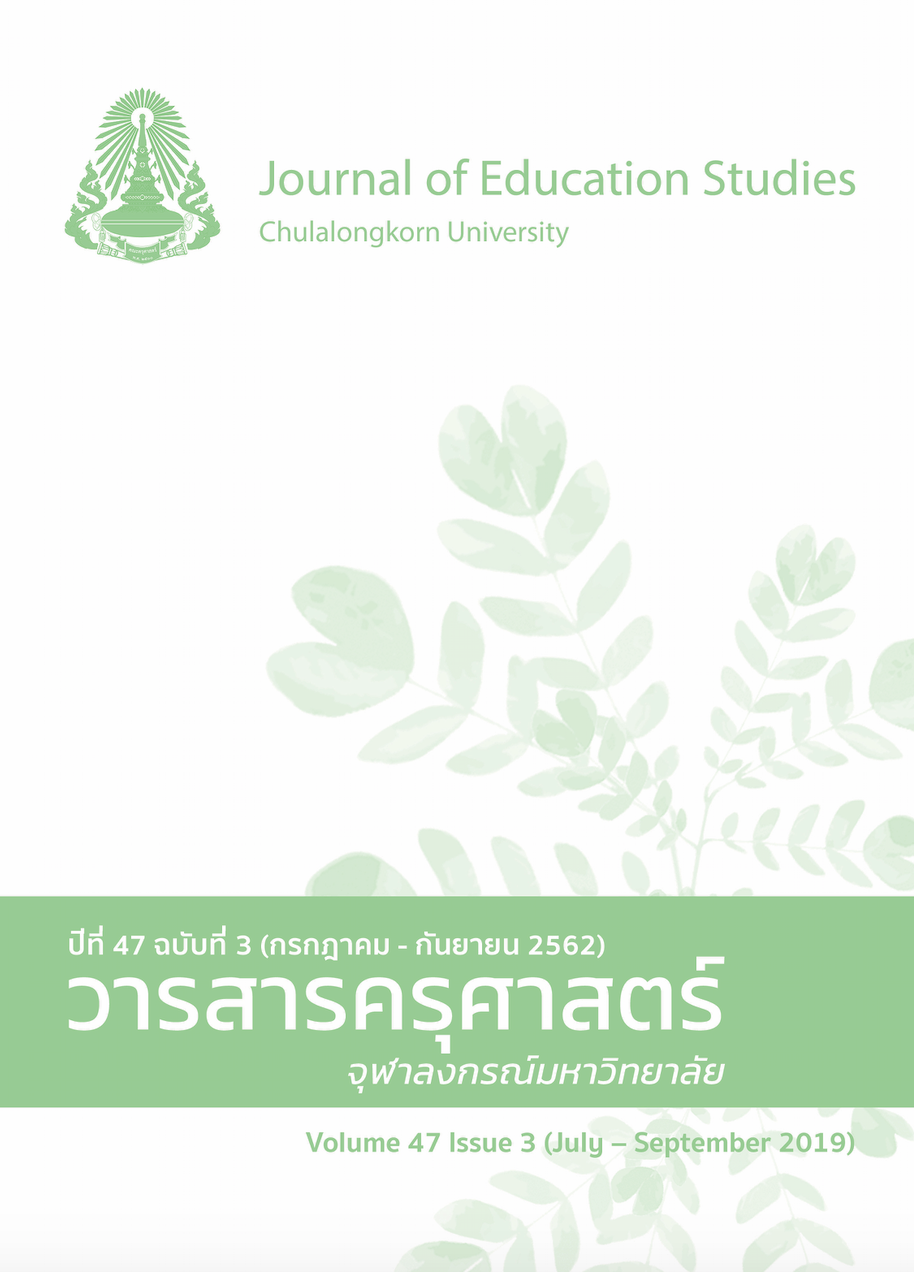Concepts about Basic Astronomy of Students in Elementary Level: A Case Study of a Hmong Ethnic Group
Keywords:
ASTRONOMY CONCEPTS, ELEMENTARY LEVEL, HMONG ETHNIC GROUPAbstract
This qualitative research aims to analyze basic astronomy concepts of 14 grade 6 Hmong students in an elementary school level by in-depth interviewing. Students were engaged to answer the 18 conceptual questions about basic astronomy phenomena by speaking, drawing and play-dough modeling. The answers of each student were decoded and categorized by determining types of conceptual understanding. The results revealed that most students had alternative conceptions about the shape of celestial objects, the formation of shadows, and celestial motion which influenced by the experiences of each student.
References
ภาษาไทย
วสุพงษ์ อิวาง, และ กรีฑา แก้วคง. (2561). การสำรวจมโนทัศน์เกี่ยวกับดวงจันทร์ของนักเรียนกลุ่มชาติพันธุ์ (ม้ง) ระดับชั้นประถมศึกษา [บทคัดย่อ]. ใน รายงานการประชุมวิชาการในระดับชาติและนานาชาติ หลักสูตรและการสอนสัมพันธ์ ครั้งที่ 4 ประจำปี 2560 ครั้งที่ 3 (น. 10). ขอนแก่น: คณะศึกษาศาสตร์ มหาวิทยาลัยขอนแก่น.
สถาบันส่งเสริมการสอนวิทยาศาสตร์และเทคโนโลยี กระทรวงศึกษาธิการ. (2560). ตัวชี้วัดและสาระการเรียนรู้แกนกลาง กลุ่มสาระการเรียนรู้วิทยาศาสตร์ (ฉบับปรับปรุง พ.ศ. 2560) ตามหลักสูตรแกนกลางการศึกษาขั้นพื้นฐาน พ.ศ. 2551. กรุงเทพมหานคร: โรงพิมพ์ชุมนุมสหกรณ์การเกษตร.
ภาษาอังกฤษ
Åberg-Bengtsson, L., Karlsson, K. G., & Ottosson, T. (2017). “Can there be a full moon at daytime?” young students making sense of Illustrations of the lunar phases. Science Education, 101(4), 616-638.
Ampartzaki, M., & Kalogiannakis, M. (2016). Astronomy in early childhood education: A concept-based approach. Early Childhood Education Journal, 44(2), 169-179.
Barnett, M., & Morran, J. (2002). Addressing children's alternative frameworks of the moon's phases and eclipses. International Journal of Science Education, 24(8), 859-879.
Baybars, G., & Can, S. (2018). Middle school students' misconceptions about the concepts of astronomy. International Education Studies, 11(11), 34-45.
Brown, T., & Brown, K. (2017). In the shadow of the moon, what type of solar eclipse will we see?. Science Activities, 54(2), 48-57.
Bryce, T. G. K., & Blown, E. J. (2013). Children's concepts of the shape and size of the earth, sun and moon. International Journal of Science Education, 35(3), 388-446.
Calderón-Canales, E., Flores-Camacho, F., & Gallegos-Cázares, L. (2013). Elementary students' mental models of the solar system. Astronomy Education Review, 12(1), 010108.
Cole, M., Cohen, C., Wilhelm, J., & Lindell, R. (2018). Spatial thinking in astronomy education research. Physical Review Physics Education Research, 14(1), 010139.
Dankenbring, C., & Capobianco, B. M. (2016). Examining elementary school students’ mental models of sun-earth relationships as a result of engaging in engineering design. International Journal of Science and Mathematics Education, 14(5), 825-845.
Heywood, D., Parker, J., & Rowlands, M. (2013). Exploring the visuospatial challenge of learning about day and night and the sun's path. Science Education, 97(5), 772-796.
Lelliott, A., & Rollnick, M. (2010). Big ideas: A review of astronomy education research 1974–2008. International Journal of Science Education, 32(13), 1771-1799.
Lindell, R. S., & Olsen, J. P. (2002). Developing the lunar phases concept inventory. Proceedings of the 2002 Physics Education Research Conference. New York: PERC Publishing.
Mills, R., Tomas, L., & Lewthwaite, B. (2016). Learning in earth and space science: a review of conceptual change instructional approaches. International Journal of Science Education, 38(5), 767-790.
Mohapatra, J. K. (1991). The interaction of cultural rituals and the concepts of science in student learning: A case study on solar eclipse. International Journal of Science Education, 13(4), 431-437.
National Research Council. (2012). A framework for K-12 science education: Practices, crosscutting concepts, and core ideas. National Academies Press.
Parnafes, O. (2012). Developing explanations and developing understanding: Students explain the phases of the moon using visual representations. Cognition and Instruction, 30(4), 359-403.
Plummer, J. D. (2014). Spatial thinking as the dimension of progress in an astronomy learning progression. Studies in Science Education, 50(1), 1-45.
Plummer, J. D., Kocareli, A., & Slagle, C. (2014). Learning to explain astronomy across moving frames of reference: Exploring the role of classroom and planetarium-based instructional contexts. International Journal of Science Education, 36(7), 1083-1106.
Posner, G. J., Strike, K. A., Hewson, P. W., & Gertzog, W. A. (1982). Accommodation of a scientific conception: Toward a theory of conceptual change. Science Education, 66(2), 211-227.
Sackes, M. (2010). The role of cognitive, metacognitive, and motivational variables in conceptual change: Preservice early childhood teachers’ conceptual understanding of the cause of lunar phases (Doctoral Dissertation, The Ohio State University). Retrieved from https://www.etd.ohiolink.edu/!etd.send_file?accession=osu1290441125&disposition=attachment.
Slater, E. V., Morris, J. E., & McKinnon, D. (2018). Astronomy alternative conceptions in pre-adolescent students in Western Australia. International Journal of Science Education, 40(17), 2158-2180.
Sneider, C., Bar, V., & Kavanagh, C. (2011). Learning about seasons: A guide for teachers and curriculum developers. Astronomy Education Review, 10(1).
Trundle, K. C., Atwood, R. K., & Christopher, J. E. (2002). Preservice elementary teachers' conceptions of moon phases before and after instruction. Journal of Research in Science Teaching, 39(7), 633-658.
Trundle, K. C., Atwood, R. K., & Christopher, J. E. (2007). Fourth‐grade elementary students’ conceptions of standards-based lunar concepts. International Journal of Science Education, 29(5), 595-616.
Vosniadou, S., & Skopeliti, I. (2017). Is it the earth that turns or the sun that goes behind the mountains? Students’ misconceptions about the day/night cycle after reading a science text. International Journal of Science Education, 39(15), 2027-2051.
Wilhelm, J. (2009). A case study of three children’s' original interpretations of the moon's changing appearance. School Science and Mathematics, 109(5), 258-275.
Wilhelm, J. (2014). Young children do not hold the classic earth's shadow misconception to explain lunar phases. School Science and Mathematics, 114(7), 349-363.
Wilhelm, J., Toland, M., & Cole, M. (2017). Evaluating middle school students’ spatial-scientific performance within earth/space astronomy in terms of gender and race/ethnicity. Journal of Education in Science, Environment and Health, 3(1), 40-50.




